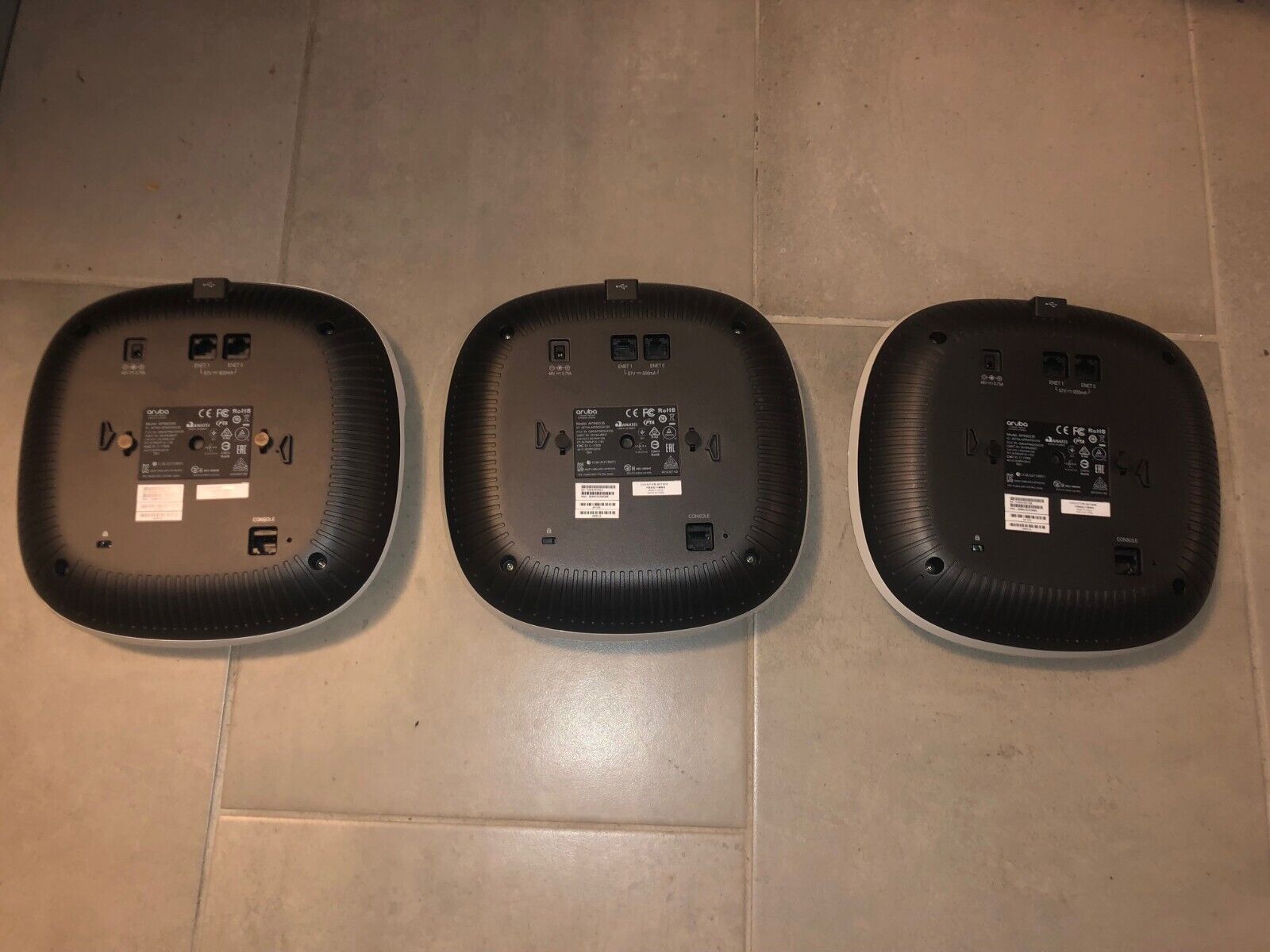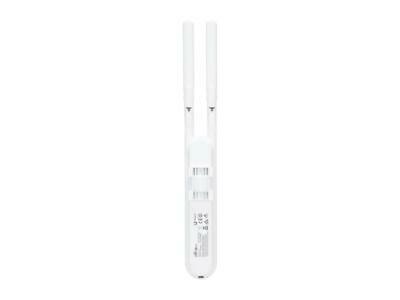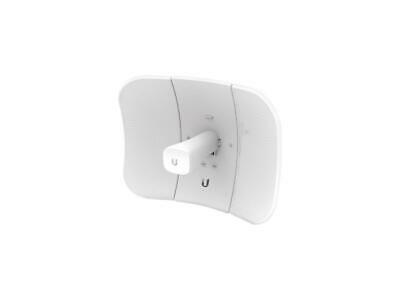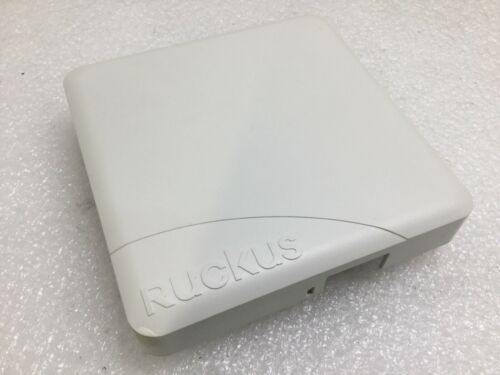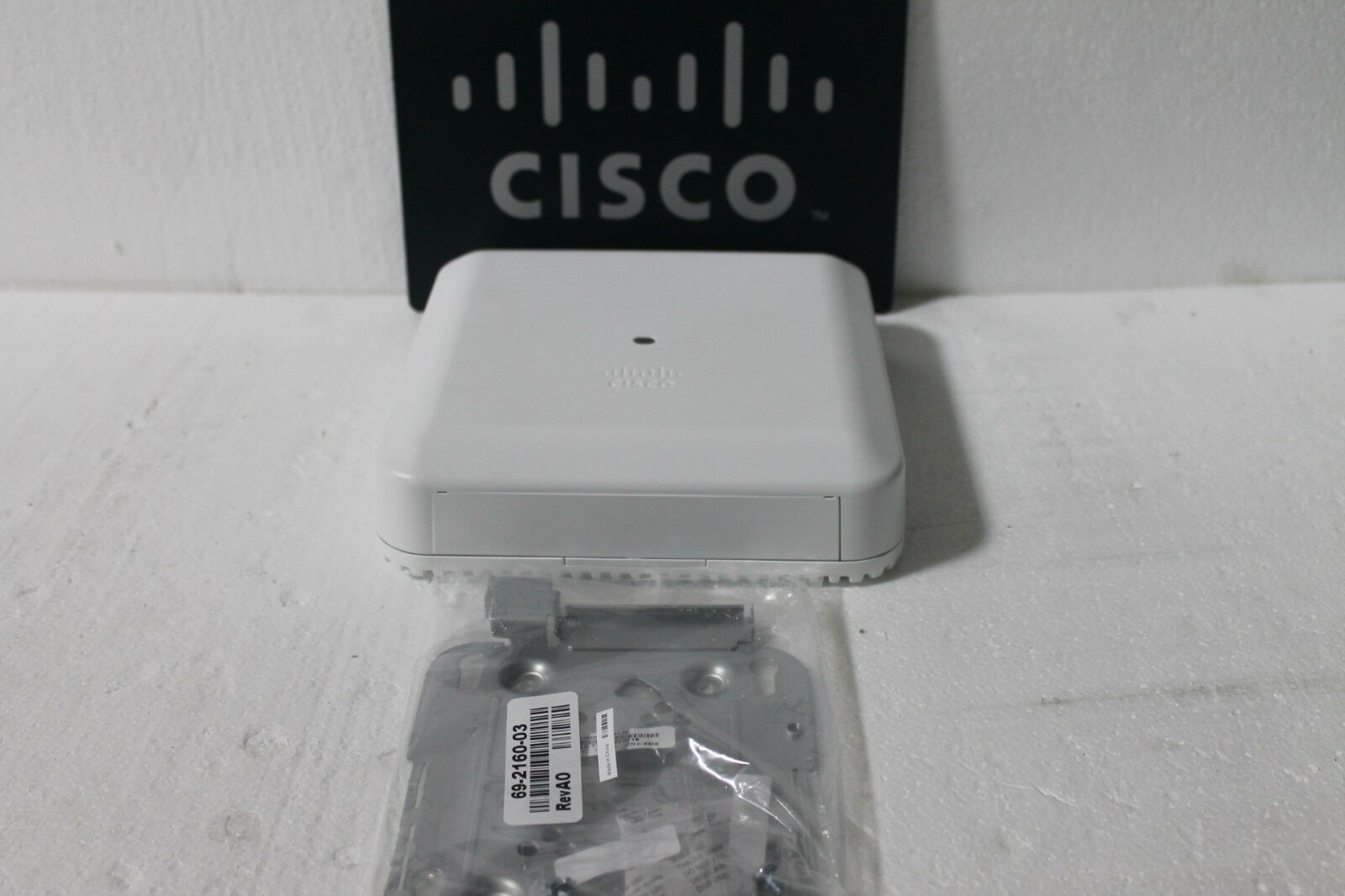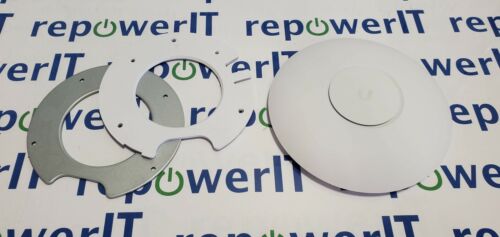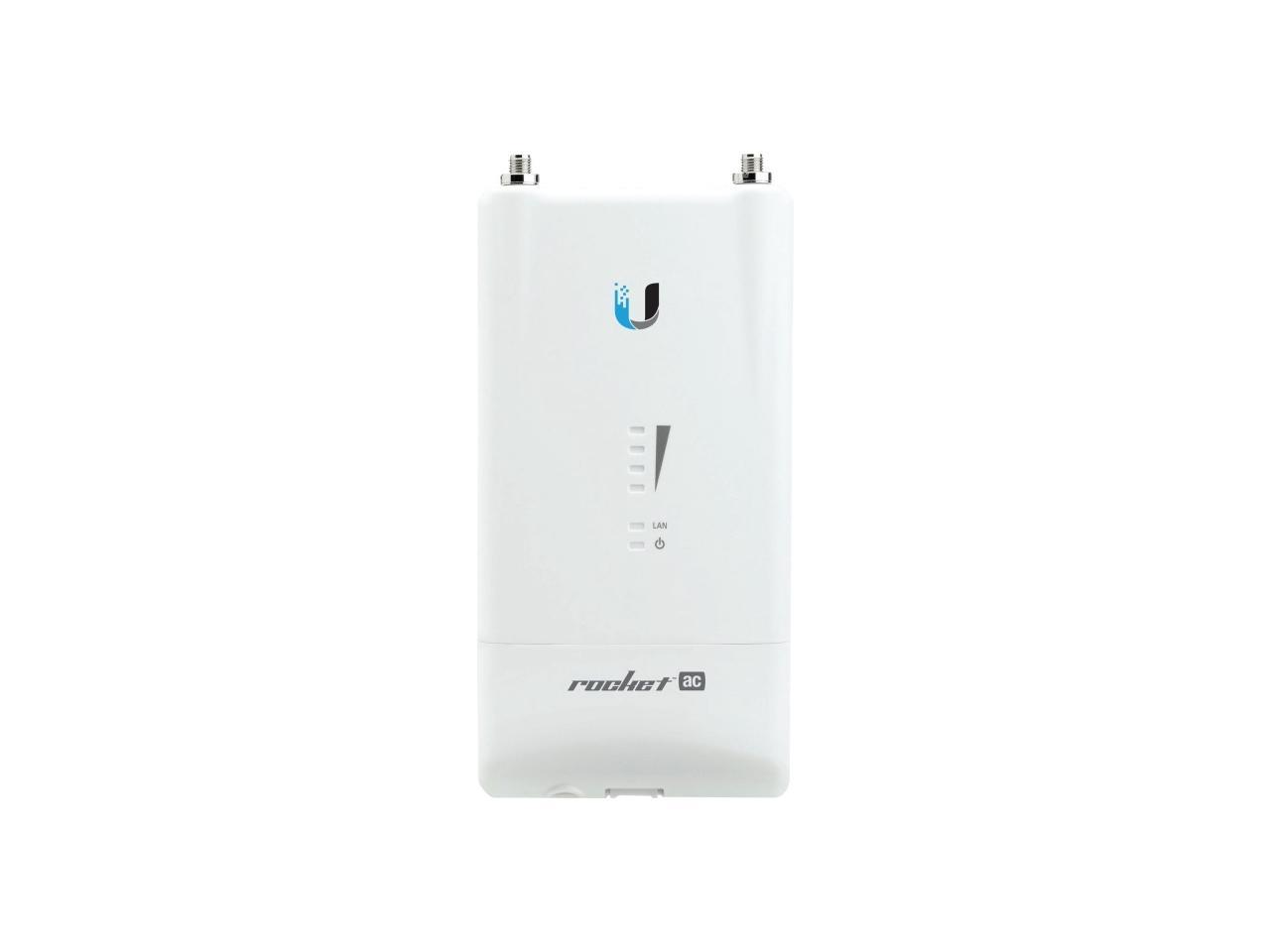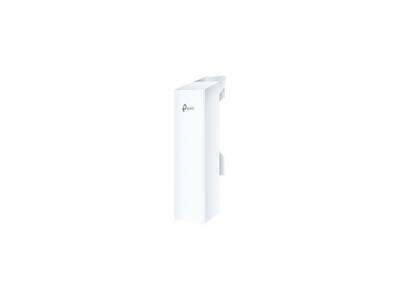-40%
Lot of 3 Aruba Networks AP-335 APIN0335 JW801A Wireless Access Point
$ 121.43
- Description
- Size Guide
Description
These came from A&M university when they upgraded their equipment. They have been tested and are in working condition. Pics are of the item(s) you will receive.Aruba AP-335 Access Point
802.11ac Wave 2 that scales up to multi-gig Ethernet
List Price:
,780.00
Our Price: ,303.94 x 3 = ,911.82
Ebay Price: 9.99
The Aruba 330 Series access points provide the fastest gigabit data speeds and superb user experience for mobile devices and applications in a digital workplace. Designed with an integrated HPE Smart Rate port to scale up to 5Gbps Ethernet, the 330 Series allows enterprises to leverage their multi-gigabit Ethernet wired network infrastructures to eliminate bottlenecks.
Thanks to ClientMatch technology, ArubaOS enables the 330 series to automatically detect and classify 802.11ac Wave 2 capable mobile devices. This allows ClientMatch to automatically collect Wave 2 capable devices under a single Wave 2 radio so that performance benefits of multi-user MIMO can be realized — without the adverse effects of slower 802.11ac and traditional 802.11n capable mobile devices. This means increased network capacity and a boost in network efficiency.
With a maximum concurrent data rate of 1,733 Mbps in the 5 GHz band and 800 Mbps in the 2.4 GHz band (for an aggregate peak data rate of 2.5Gbps), the 330 Series Access Points deliver a best-in-class, next-generation 802.11ac Wi-Fi infrastructure that is ideal for lecture halls, auditoriums, public venues, and high-density office environments.
The high performance and high density 802.11ac 330 Series Access Points support 160 MHz channel bandwidth (VHT160), 4-stream multi-user MIMO (MU-MIMO) and 4 spatial streams (4SS). They provide simultaneous data transmission to multiple devices, maximizing data throughput and improving network efficiency.
The 330 Series Access Points have an integrated Bluetooth Aruba Beacon that simplifies the remote management of a network of large-scale battery-powered Aruba beacons while also providing advanced location and indoor wayfinding, and proximity-based push notification capabilities. It enables businesses to leverage mobility context to develop applications that will deliver an enhanced user experience and increase the value of the wireless network for organizations.
Multi-gig Ethernet
Leverage wired multi-gig NBASE-T-compatible Ethernet infrastructure to eliminate bottlenecks in high-density environments.
ClientMatch unleashes MU-MIMO
Aruba ClientMatch software groups Wave 2 clients together, enabling 4x4:4SS MU-MIMO. That means a faster, more efficient network.
Integrated Bluetooth Beacon
330 series APs have an integrated BLE Beacon to simplify management of a large-scale network of battery-powered Aruba Beacons.
Choose your operating mode
The Aruba 330 Series Access Points offer a choice of operating modes to meet your unique management and deployment requirements.
Controller-managed mode
– When managed by Aruba Mobility Controllers, Aruba 330 Series Access Points offer centralized configuration, data encryption, policy enforcement and network services, as well as distributed and centralized traffic forwarding.
Aruba Instant mode
– In Aruba Instant mode, a single AP automatically distributes the network configuration to other Instant APs in the WLAN. Simply power-up one Instant AP, configure it over the air, and plug in the other APs – the entire process takes about five minutes. If WLAN requirements change, a built-in migration path allows the 330 Series Instant APs to become part of a WLAN that is managed by a Mobility Controller.
Remote AP (RAP) for branch deployments
Air monitor (AM) for wireless IDS, rogue detection and containment
Spectrum analyzer, dedicated or hybrid, for identifying sources of RF interference
Secure enterprise mesh
AP-334 and AP-335 Specifications
AP-330 Series Specifications
AP-334 (controller-managed) and IAP-334 (Instant):
802.11ac – 5 GHz 4x4 MIMO (1,733 Mbps max rate) and 2.4 GHz 4x4 MIMO (800 Mbps max rate) radios, with a total of four dual-band RP-SMA connectors for external antennas
AP-335 (controller-managed) and IAP-335 (Instant):
802.11ac – 5 GHz 4x4 MIMO (1,733 Mbps max rate) and 2.4 GHz 2x2 MIMO (800 Mbps max rate) radios, with a total of twelve integrated omni-directional downtilt dual- band antennas
Wireless Radio Specifications
AP type: Indoor, dual radio, 5 GHz 802.11ac 4x4 MIMO and 2.4 GHz 802.11n 4x4 MIMO
In addition to 802.11n, the 2.4 GHz radio supports all 802.11ac features as well (proprietary extension)
Software-configurable dual radio supports 5 GHz (Radio 0) and 2.4 GHz (Radio 1)
5 GHz:
Four spatial stream Single User (SU) MIMO for up to 1,733 Mbps wireless data rate to individual 4x4 VHT80 or 2x2 VHT160 client devices
Four spatial stream Multi User (MU) MIMO for up to 1,733 Mbps wireless data rate to up to three MU-MIMO capable client devices simultaneously
2.4 GHz: Four spatial stream Single User (SU) MIMO for up to 800 Mbps wireless data rate to individual 4x4 VHT40 client devices (600 Mbps for HT40 802.11n client devices)
Support for up to 255 associated client devices per radio, and up to 16 BSSIDs per radio
Supported frequency bands (country-specific restrictions apply):
2.400 to 2.4835 GHz
5.150 to 5.250 GHz
5.250 to 5.350 GHz
5.470 to 5.725 GHz
5.725 to 5.850 GHz
Available channels: Dependent on configured regulatory domain
Dynamic frequency selection (DFS) optimizes the use of available RF spectrum
Supported radio technologies:
802.11b: Direct-sequence spread-spectrum (DSSS)
802.11a/g/n/ac: Orthogonal frequency-division multiplexing (OFDM)
Supported modulation types:
802.11b: BPSK, QPSK, CCK
802.11a/g/n/ac: BPSK, QPSK, 16-QAM, 64-QAM, 256-QAM
Transmit power: Configurable in increments of 0.5 dBm
Maximum (aggregate, conducted total) transmit power (limited by local regulatory requirements):
2.4 GHz band: +24 dBm (18 dBm per chain)
5 GHz band: +24 dBm (18 dBm per chain)
Note: conducted transmit power levels exclude antenna gain. For total (EIRP) transmit power, add antenna gain
Maximum ratio combining (MRC) for improved receiver performance
Cyclic delay/shift diversity (CDD/CSD) for improved downlink RF performance
Short guard interval for 20 MHz, 40 MHz, 80 MHz and 160 MHz channels
Space-time block coding (STBC) for increased range and improved reception
Low-density parity check (LDPC) for high-efficiency error correction and increased throughput
Transmit beam-forming (TxBF) for increased signal reliability and range
Supported data rates (Mbps):
802.11b: 1, 2, 5.5, 11
802.11a/g: 6, 9, 12, 18, 24, 36, 48, 54
802.11n: 6.5 to 600 (MCS0 to MCS31)
802.11ac: 6.5 to 1,733 (MCS0 to MCS9, NSS = 1 to 4 for VHT20/40/80, NSS = 1 to 2 for VHT160)
802.11n high-throughput (HT) support: HT 20/40
802.11ac very high throughput (VHT) support: VHT 20/40/80/160
802.11n/ac packet aggregation: A-MPDU, A-MSDU
WiFi Antennas
AP-334/IAP-334: Four RP-SMA connectors for external dual band antennas. Internal loss between radio interface and external antenna connectors (due to diplexing circuitry): 2.3 dB in 2.4 GHz and 1.2 dB in 5 GHz.
AP-335/IAP-335
Four integrated 2.4 GHz downtilt omni-directional antennas for 4x4 MIMO with maximum antenna gain of 4.3 dBi per antenna.
Each 5 GHz radio chain has both a vertically and a horizontally polarized antenna element; AP software automatically and dynamically selects the best set of elements for each data packet transmitted or received.
Eight integrated 5 GHz downtilt omni-directional antennas for 4x4 MIMO with maximum antenna gain of 5.4 dBi (vertical)/4.2 dBi (horizontal) per antenna.
Built-in antennas are optimized for horizontal ceiling mounted orientation of the AP. The downtilt angle for maximum gain is roughly 30 degrees.
The maximum gain of the combined (summed) antenna patterns for all elements operating in the same band is 8.6 dBi in 2.4 GHz and 8.5 dBi (vertical)/8.1 dBi (horizontal) in 5 GHz.
Other Interfaces
One HPE Smart Rate port (RJ-45, maximum negotiated speed 5 Gbps)
Auto-sensing link speed (100/1000/2500/5000BASE-T) and MDI/MDX
802.3az Energy Efficient Ethernet (EEE) - PoE-PD: 48 Vdc (nominal) 802.3at PoE
One 10/100/1000BASE-T Ethernet network interface (RJ-45)
Auto-sensing link speed and MDI/MDX
802.3az Energy Efficient Ethernet (EEE)
PoE-PD: 48 Vdc (nominal) 802.3at PoE
DC power interface, accepts 1.35/3.5-mm center-positive circular plug with 9.5-mm length
USB 2.0 host interface (Type A connector)
Bluetooth Low Energy (BLE) radio
Up to 4 dBm transmit power (class 2) and -91 dBm receive sensitivity
Integrated antenna with roughly 30 degrees downtilt and peak gain of 5.1 dBi (AP-334/IAP-334) or 2.2 dBi (AP-335/IAP-335)
Visual indicators (tri-color LEDs): For system and radio status
Reset button: Factory reset (during device power up)
Serial console interface (RJ-45, RS232)
Kensington security slot
Power Sources and Consumption
The AP supports direct DC power and Power over Ethernet (PoE)
When both power sources are available, DC power takes priority over PoE
Power sources are sold separately
Direct DC source: 48Vdc nominal, +/- 5%
Interface accepts 1.35/3.5-mm center-positive circular plug with 9.5-mm length
Power over Ethernet (PoE): 48 Vdc (nominal) 802.3af/802.3at compliant source
When using IPM, the AP may enter power-save mode with reduced functionality when powered by a PoE source (see details on Intelligent Power Monitoring in this datasheet)
Without IPM the AP will apply some fixed restrictions when using PoE:
The USB interface is disabled when using an 802.3at PoE power source
The USB interface and second Ethernet port are disabled, and both radios operate in 1x1 mode when using an 802.3af POE power source
Maximum (worst-case) power consumption: 25.3W (802.3at PoE), 13.2W (802.3af PoE) or 25W (DC)
Excludes power consumed by external USB device (and internal overhead); this could add up to 5.9W (PoE or DC) for a 5W/1A USB device
Maximum (worst-case) power consumption in idle mode: 10.9W (PoE or DC)
Mounting
The AP ships with two (white) mounting clips to attach to a 9/16-inch or 15/16-inch flat T-bar drop-tile ceiling.
Several optional mount kits are available to attach the AP to a variety of surfaces; see the Ordering Information section below for details
Mechanical
Dimensions/weight (unit, excluding mount accessories):
225 mm (W) x 224 mm (D) x 52 mm (H), 8.9” (W) x 8.9” (D) x 2.0” (H)
1150g/41oz
Dimensions/weight (shipping):
335 mm (W) x 290 mm (D) x 76 mm (H), 13.2” (W) x 11.4” (D) x 3.0” (H)
1550g/55oz
Environmental
Operating:
Temperature: 0° C to +50° C (+32° F to +122° F)
Humidity: 5% to 95% non-condensing
Storage and transportation:
Temperature: -40° C to +70° C (-40° F to +158° F)
Regulatory
FCC/Industry of Canada
CE Marked
R&TTE Directive 1995/5/EC
Low Voltage Directive 72/23/EEC
EN 300 328
EN 301 489
EN 301 893
UL/IEC/EN 60950
EN 60601-1-1 and EN 60601-1-2
For more country-specific regulatory information and approvals, please see your Aruba representative.
Reliability
MTBF: 531,662hrs (61yrs) at +25C operating temperature
Regulatory Model Number
AP-334 and IAP-334: APIN0334
AP-335 and IAP-335: APIN0335
Certifications
CB Scheme Safety, cTUVus
UL2043 plenum rating
Wi-Fi Alliance (WFA) certified 802.11a/b/g/n/ac
Warranty
Aruba limited lifetime warranty
Minimum Software Versions
ArubaOS 6.5.0.0
Aruba InstantOS 4.3.0.0

